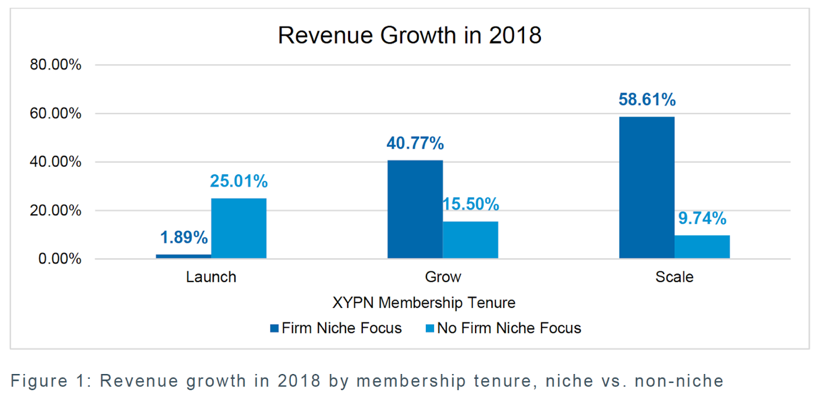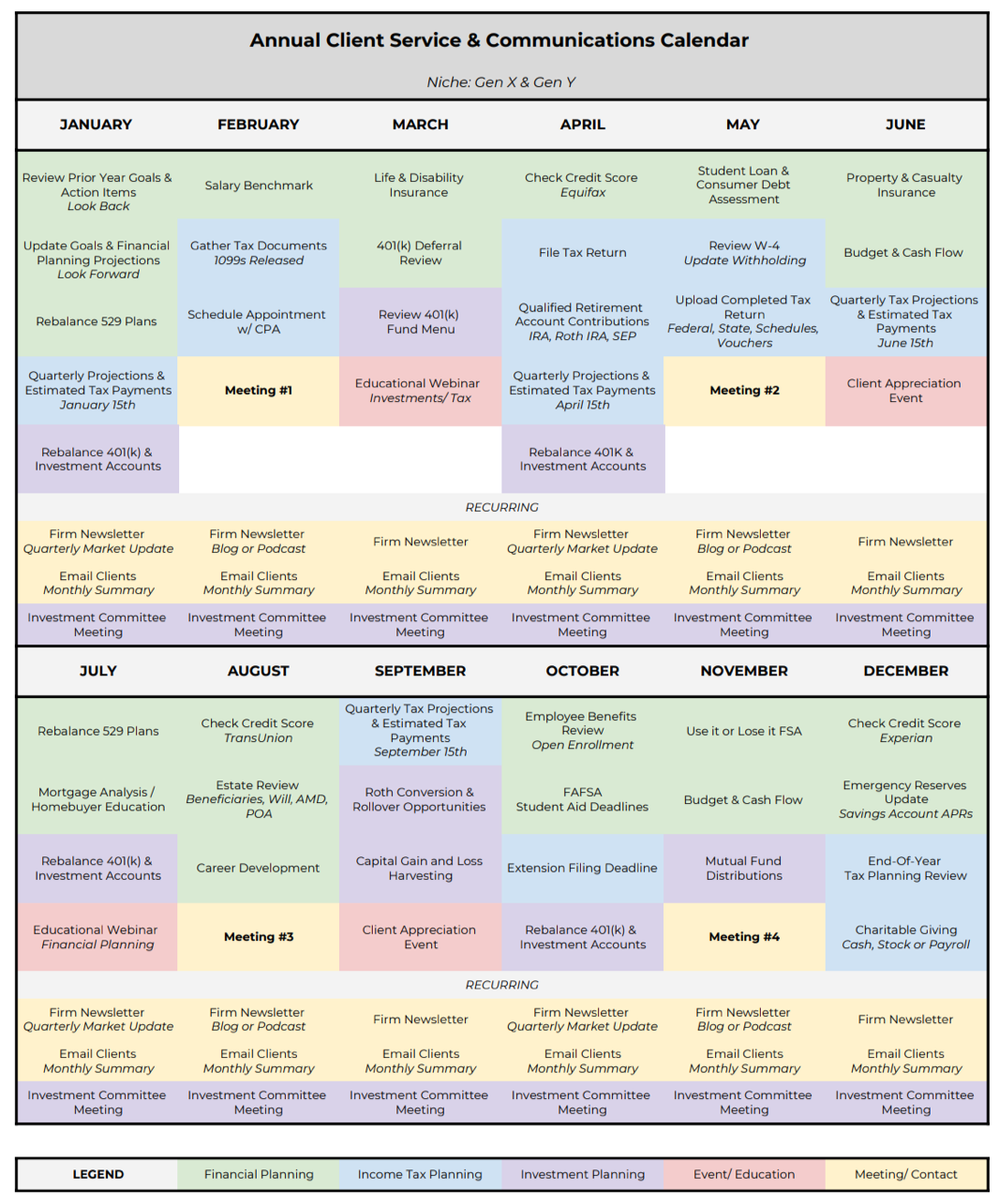How to refine your RIA's client service model
Share this
This year’s 2019 XYPN Advisor Benchmarking Study indicates the majority of XYPN advisors offer between four to eight services on top of general financial planning, with very few advisors offering more than ten services. These consultative services often include retirement planning, tax planning, discretionary investment management, investment advice, and budgeting.
Overextending the services you offer may lead to inefficiencies in your financial planning process. Benchmarking data suggests that financial advisors should strike a balance between the service areas that clients value and those that they have expertise in. Structuring your service offerings is the first step in establishing efficient processes and workflows.
Value (Clients) + Expertise (Financial Planner) = Service Offerings
Annual Client Service & Communications Calendar
Most financial planners have already spent adequate time thinking about their service offerings for marketing and sales purposes. However, they often need help organizing their various services to effectively present to prospects and revisit with their clients throughout the planning engagement. A client service calendar is a tangible document that illustrates key work you do for your clients. Clients may not fully understand or appreciate how much is being done on their behalf. Turning the intangible work of financial planning into something tangible can be done through the use of a service calendar. By structuring your services monthly or quarterly, you can build relevant processes and workflows that will keep you organized. When you refine your service model by building a service calendar, you will improve your client experience through increased consistency, accountability, and productivity.
When do you start using a service calendar? The answer to this question depends on how you have your financial planning offering structured. For those of you that immediately navigate into an ongoing planning relationship, you will start the service calendar after the engagement and agreement(s) are signed. Give yourself a few weeks for onboarding, and then be prepared to start your clients with the first month. Conversely, some of you choose to prepare comprehensive, upfront financial plans over the first three or four months. In this case, it would be appropriate to address the service calendar during the initial plan delivery meeting. This will help convert your one-time clients into an ongoing relationship. While the start date of a service calendar is dependent on your financial planning offering, the end date should be the client’s 12th month. You will have clients graduating your Year 1 service calendar at various points in time since new client onboarding happens sporadically throughout the year. Here are a few examples to highlight the appropriate start and stop (i.e. graduation) dates for a Year 1 service calendar.
Monthly Retainer
Malcolm signs a financial planning engagement agreeing to pay $200/month in February 2019. You would start Malcolm on a service calendar immediately after the initial onboarding is complete and the financial planning work begins in March 2019. He will then complete all 12 months and graduate from the calendar in February 2020. At this time, you may choose to navigate him into a pared down Year 2 calendar.
Monthly Retainer + Upfront Plan Fee
Arlene becomes a client in June 2019. She signs a financial planning engagement agreeing to pay a $1,000 upfront financial plan fee, and then $150/ month going forward. Arlene would start on a service calendar after the initial plan delivery meeting; typically, 3 months from the signed engagement. In this case, you delivered her financial plan in September 2019, and you will graduate her in August 2020.
One-Time Financial Plan
Carolyn becomes a client in November 2019. She signed an engagement agreeing to pay $3,000 for an upfront financial plan. The engagement covers 3-months of financial planning work, including four meetings with you. At the end of the 3-month engagement, you present a comprehensive financial plan and leverage the service calendar to convert Carolyn to an ongoing client. Carolyn was pleased with your work and happily signs a new engagement letter; the service calendar will now kick in February 2020.
Admit it, you've thought about increasing your fee. Here's why you SHOULD →
Building It
Now that you have a good understanding of the definition and potential uses of a service calendar, it’s time to focus on how to build it. Using the Service Offering Template (click here to download!), we will help you identify your broad offerings and then get more granular into the specific services you provide to your clients. Some examples of broad service offerings include financial planning, tax planning, investment planning, and content creation. I have also heard of financial coaching, workshops, seminars, and other programs our members include. Think about what your firm does best and write it down. Depending on your business, tax planning and investment planning may look different. Even if you do not prepare income tax returns or projections, you are likely consulting on retirement account contributions and savings strategies. Similarly, if you are not managing assets, you may still be providing investment advice or guidance. Please use the fillable template to organize your thoughts. There are some examples outlined here for your consideration.
Financial Planning
- Life & Disability Insurance
- Student Loan & Consumer Debt Assessment
- Budget & Cash Flow
- Mortgage Analysis/ Homebuyer Education
- Employee Benefits Review
Tax Planning
- File Tax Return
- Qualified Retirement Account Contributions
- Review W-4 & Update Withholding
- End-Of-Year Tax Planning Review
- Charitable Giving
Investment Planning
- Investment Planning
- Rebalance 401(k) & Investment Accounts
- Capital Gain and Loss Harvesting
- Mutual Fund Distributions
- Investment Committee Meeting
Content Creation
- Monthly Firm Newsletter
- Quarterly Market Update
- Blogs
- Podcasts
- Monthly Summary Emails
Implementing It
At this point, you have a solid list of your service offerings to leverage and build your Year 1 service calendar. An example of the Annual Client Service & Communications Calendar I developed in August can be found at the end of this blog for your reference and consideration. You will notice there are a few more dropdowns in the template that we haven’t addressed yet.
Are any of the specific services time-specific? Things related to tax planning are easy to identify, but make sure to look thoroughly at your financial planning items and deadlines (i.e., FAFSA and open enrollment). Using the template and select “T” for anything time-specific.
What happens or should happen every month? An example would be a monthly firm newsletter. Use the dropdown and select “R” next to everything recurring. Recurring items will fall in a separate section of your service calendar.
Client meetings and contact frequency. Use the template to identify your preferred client contact frequency. If your goal is to meet with your clients quarterly, then place four meetings on your service calendar. If you are only able to meet with them two or three times, the service calendar is not a failure. Remember, the service calendar helps hold you accountable and create consistency; it can be aspirational.
Three Questions
After you have worked through this exercise and drafted your first service calendar or possibly refined one you already had, ask yourself these essential questions before you finalize it.
Is it transparent? Will your prospects be able to understand it during an initial consultation or prospect meeting? Can you communicate it effectively and transparently?
Is it realistic? Will it create client buy-in? Does it motivate your prospects and clients to work with you?
Is it scalable? Can your business take on unexpected growth under the service model you built? Are you able to work through the calendar simultaneously with clients in different stages?
Firm Journey
Using XYPN’s Firm Journey infographic, I will provide a few ways in which you can implement and benefit from a service calendar based on your client count.
Registering and Preparing to Launch
No clients
Building a service calendar before you sign your first client can help with your registration process, facilitate more productive conversations with our compliance team, and get your website up and running more quickly. When you are equipped with a service calendar at this stage, you are also better prepared for your initial prospecting conversations.
Launching & Refining
0 to 20 clients
At this phase of the Firm Journey, you should spend some time evaluating and refining your service model. This is the time to make changes to your existing processes and offerings. By taking a step back and organizing your services, you will be able to reach the next stage more quickly. Because you are working with your existing clients so efficiently, you will be better positioned to spend ample time developing new business.
Growing & Evaluating
21 to 75 clients
When you are ready to grow and evaluate your business, a service calendar will help you define the processes that should be formally built in your CRM. By establishing core workflows in this phase, you can manage existing and new clients by relying on automation. Regardless of your client count goals and firm growth goals, the use of workflows is a key differentiator among advisory firms.
Scaling
75+ clients
In this phase, members choose what type of firm they are trying to build. While some opt for lifestyle practices, others strive to build teams through boutique or enterprise practices. If you are currently in the scaling phase, you likely have a paraplanner, associate advisor, or administrative assistant who can help you with this service calendar initiative. You likely have marketing materials that outline your services and you may benefit from restructuring them into a service calendar.
Adapting It
Year 2
While a Year 1 service calendar is essential in building and refining your client service model, some of our members strive to build a calendar for Year 2 and beyond. By transitioning clients from the intensive onboarding and first-year experience into a more manageable workload for both the client and advisor you are able to scale your service model. A Year 2 service calendar will help show your continued value while you build trust with your clients by keeping them engaged in the process. While the Year 2 calendar can keep the structure of your first-year calendar, you may want to change from monthly to quarterly buckets. By pairing down a service calendar to the essential, core service offerings, you can highlight your great work, manage expectations, and get your clients excited to continue the relationship.
Customizing It
Niche
Alternatively, you may choose to customize a service calendar for your niche. For those of you that work with teachers, service members, tech professionals, attorneys, or corporate executives, this is where a niche calendar comes into play. As a part of the exercise above, you should ask what your niche needs and expects from you. Our benchmarking study indicates when you are equipped with a niche focus, you have a story to share about your firm. When you build a service calendar with a niche in mind, you can communicate your story in a meaningful way.
If a prospective client cannot understand exactly what you do, how can the prospect value your services and expertise? A niche will help you identify services that are important to your ideal client. You can leverage your niche to do relevant financial planning and even batch financial planning when appropriate. While it may take some time to effectively develop a niche strategy, having such a strategy can lead to stronger long-term growth. You can see revenue growth based on membership tenure below.

FAQs
Do I need to give every client a personalized service calendar?
No, you don’t need to give every client a customized service calendar. This wouldn’t be scalable if you were to spend time personalizing your standard service offerings. The best practice here is to build a service calendar that reflects your firm’s offerings in a way that speaks to your expertise and highest value. When you do this, you will be able to have discussions with your prospects and clients to familiarize them with your planning process. If you want to take it a step further, you can laminate it for in-person meetings and cross off topics that don’t apply to the prospect or client you are meeting with. Similarly, for virtual meetings, you can use your pen tool to do the same.
Will a service calendar overwhelm my prospects and current clients?
It can be overwhelming if you post a service calendar on your website or use it in marketing materials without taking the time to explain it thoroughly to your clients and prospects. The best way to overcome any sort of stress around a service calendar is to explain it frequently and set expectations early. After the initial introduction to the service calendar, you must incorporate it into your quarterly or semi-annual meetings going forward. The service calendar should be a core pillar of how you do business.
What happens if I don’t get to a topic in a timely fashion (i.e., in the correct month)?
There are certain elements on your service calendar that are time-sensitive. However, the service calendar is simply a guideline and your clients won’t be disappointed if a topic was missed or not fully addressed. The service calendar creates structure and helps your clients understand what financial planning means. If something is missed because of inaction or inability to complete a proper analysis, you should revisit it with your clients at the earliest convenience and explain the plan of action.
What do I do when a client comes to me with a certain question that falls much later on the calendar?
Always address your client’s pain points and challenges before beginning on the service calendar; otherwise, you may lose your client’s interest and motivation for meeting with you. If a client comes to you worried about student loans, you should spend time addressing that in the first few weeks in great detail before beginning on other topics in the service calendar.
How else should I use a service calendar?
In addition to using a service calendar to improve your conversations with prospects and guide your clients through a comprehensive, ongoing financial planning relationship, you should use your service calendar to build out workflows. One idea here is to build detailed workflows related to specific financial planning topics (i.e., education planning). Another idea is to build workflows around your monthly or quarterly buckets to keep clients moving through the planning process more consistently.
Annual Client Service & Communications Calendar
Year 1 Example

 About the Author
About the Author
After working as a financial planner at a large fee-only RIA in Northern Virginia, Emily joined XYPN’s Advisor Success team. As a CFP® professional and Enrolled Agent, Emily shares her financial planning knowledge and experience with members as they start, run and grow their businesses. She received her M.S. in Advanced Personal Financial Planning and a Financial Therapy Graduate Certificate from Kansas State University. Emily also completed Wharton’s Executive Education Program in Client Psychology and graduated from the FPA Residency Program.
Additionally, she serves as a Graduate Teaching Assistant for KSU’s financial planning program. She recently completed terms on the Financial Planning Association National Capital Area Board as the NexGen Director, and Virginia Tech’s Recent Alumni Board as the Outreach Chair.
Share this
- Advisor Blog (697)
- Financial Advisors (222)
- Growing an RIA (121)
- Digital Marketing (87)
- Marketing (84)
- Community (81)
- Business Development (78)
- Start an RIA (76)
- Coaching (72)
- Running an RIA (71)
- Compliance (69)
- Client Acquisition (65)
- Technology (65)
- Entrepreneurship (61)
- XYPN LIVE (59)
- Sales (49)
- Practice Management (44)
- Client Engagement (41)
- Bookkeeping (40)
- Investment Management (40)
- XYPN Books (38)
- Fee-only advisor (37)
- Scaling an RIA (33)
- Employee Engagement (31)
- Lifestyle, Family, & Personal Finance (31)
- Financial Education & Resources (27)
- Client Services (26)
- Journey Makers (21)
- Market Trends (21)
- Process (14)
- Niche (11)
- SEO (9)
- Career Change (8)
- Partnership (7)
- Transitioning Your Business (7)
- Sapphire (4)
- Transitioning To Fee-Only (4)
- Social Media (3)
- Transitioning Clients (3)
- Emerald (2)
- Persona (2)
- RIA (2)
- Onboarding (1)
Subscribe by email
You May Also Like
These Related Stories

The Power of Tax Planning with the XY Tax Solutions Tax Team
Jul 7, 2023
6 min read

How to Provide Philanthropic Planning in Seven Easy Steps
May 26, 2016
6 min read






